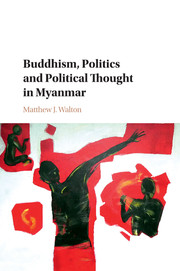Book contents
- Frontmatter
- Dedication
- Contents
- Acknowledgments
- A Note on Language and Usage
- Introduction
- 1 A Brief Political History and Cast of Characters
- 2 Building Blocks of a Moral Universe
- 3 On Human Nature and the Nature of Politics
- 4 Order and Freedom/Liberation: Purposes of Politics
- 5 What is “Politics” and What Constitutes “Participation”?
- 6 Discipline, Rights, and Morality: “Democracy” in Contemporary Myanmar
- Conclusion
- Appendix Glossary of Burmese and Buddhist Terms
- Bibliography
- Index
1 - A Brief Political History and Cast of Characters
Published online by Cambridge University Press: 22 December 2016
- Frontmatter
- Dedication
- Contents
- Acknowledgments
- A Note on Language and Usage
- Introduction
- 1 A Brief Political History and Cast of Characters
- 2 Building Blocks of a Moral Universe
- 3 On Human Nature and the Nature of Politics
- 4 Order and Freedom/Liberation: Purposes of Politics
- 5 What is “Politics” and What Constitutes “Participation”?
- 6 Discipline, Rights, and Morality: “Democracy” in Contemporary Myanmar
- Conclusion
- Appendix Glossary of Burmese and Buddhist Terms
- Bibliography
- Index
Summary
This chapter provides a short account of Burmese political history from about the middle of the nineteenth century to the present. Although it necessarily gives a broad-brush overview, the purpose is to provide context for the actors and events in the following chapters. It also includes short descriptions of some of the individuals whose ideas about politics are analyzed throughout the book.
To the best of current knowledge of Burmese history, the region during the precolonial era consisted of a succession of kingdoms and smaller political units, whose nebulous areas of control expanded and contracted through warfare and intermarriage. The Burman king Anawrahta founded the Pagan Dynasty in the early eleventh century and Theravāda Buddhism and Burman language and culture gradually became dominant over the next few centuries. The rulers of the final Konbaung Dynasty (founded by King Alaungpaya in 1752) were forced to contend with the incursions of the British, losing territory in stages beginning in 1824 and ending with the British deposition of King Thibaw in 1885 and the formal annexation of the entire country in 1886.
The penultimate king of the Konbaung dynasty, Mindon, instituted a series of reforms in the economic, political, and religious spheres, designed to strengthen the Burmese state against the colonial threat, but was unsuccessful in this respect, especially as by that time he only directly controlled upper Burma (Koenig 1990 and Myo Myint 1987). Mendelson describes Mindon as “something of a bridge between the old royal order and the new world of the Europeans, and there is evidence that he was amply conscious of this” (Mendelson 1975, 83). Indeed, there were a number of innovative policies enacted during his reign that support this characterization, including an attempt to have greater control over the flow of information by publishing a newspaper (Charney 2006, 199).
Faced with a severely weakened political base, Mindon sought to shore up his religious standing through reforms in that field as well, although this should not be seen as a purely instrumental move, as most descriptions of Mindon present him as a genuinely pious and religiously engaged ruler. However, Mendelson suggests the possible explanation that, in seeking to enhance his direct control over monastic activities, Mindon engaged in a divide and rule strategy that allowed the previously central monastic authority to be dispersed and connected more directly to him (Mendelson 1975, 112–114).
- Type
- Chapter
- Information
- Buddhism, Politics and Political Thought in Myanmar , pp. 22 - 35Publisher: Cambridge University PressPrint publication year: 2016



